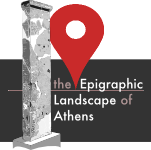Updates #6: Inscribed laws in post-403/2 BCE Athens
by Antonia Di Tuccio
The IV cent. BCE represents a turning point both in the history of Athens and in its epigraphical landscape. After the Peloponnesian War, Athens lost its leading role in Greece and underwent changes in its political, institutional and socio-economic order, which would have led to the arrangement of Hellenistic-Roman society. Likewise, in the epigraphic landscape there were some novelties which would have strengthened in the following centuries. Particularly, the Agora and other locations began arising as places of display for state decrees, in addition to the Acropolis, which had ruled the scene during the V cent. BCE, owing to its multi-faceted functions.
However, a preliminary analysis of the laws with intact publication clause could already reveal that they were set up in places relevant to their content and/or to their addressees. The ones displayed on the Acropolis seemed also to follow the same logic: they were set up there no more and not only for the ideological function of the plateau, but for the relevance of location to substantive content. It seems clear that, at a time when new economic categories emerged more strongly and the "private" dimension joined the "public" one, within the polis new spaces began being used in order to meet the needs of an evolving society.
Antonia Di Tuccio (Naples)
Published on: 21 Nov 2018 by Chiara Lasagni


